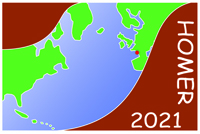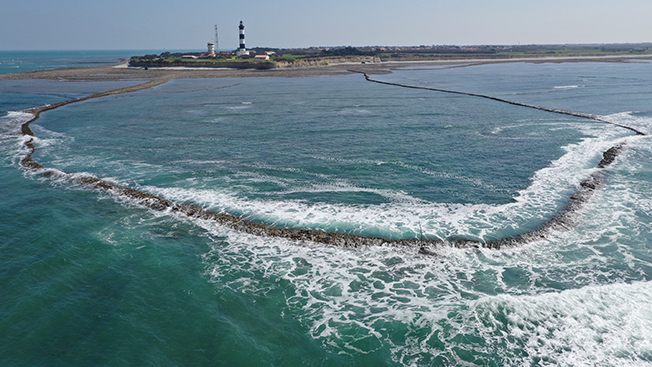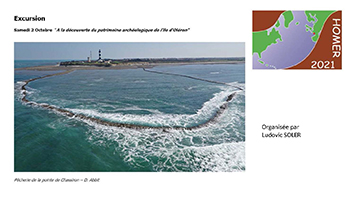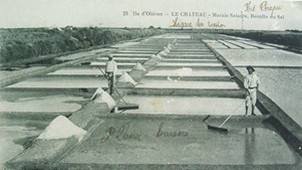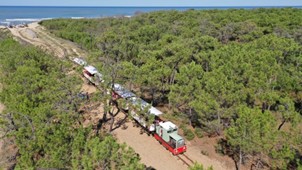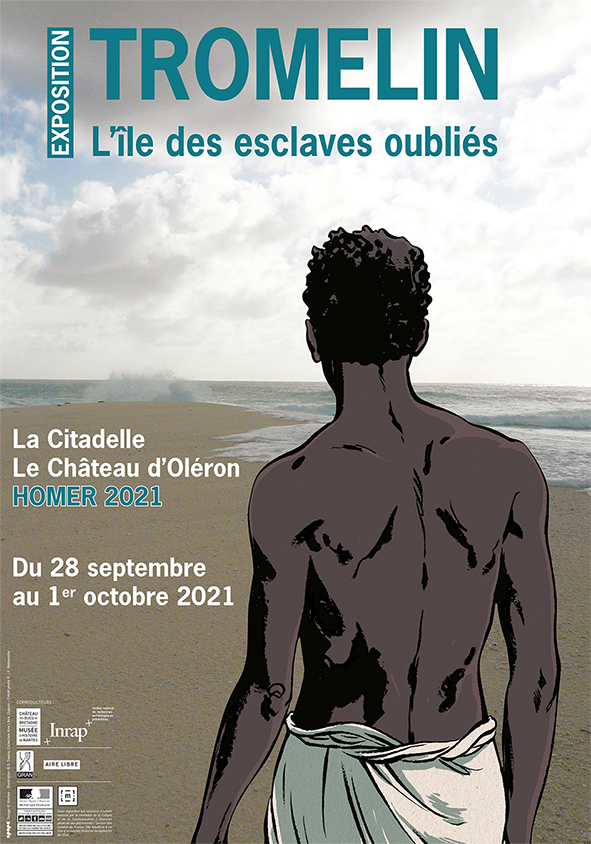Excursion & ActivitiesExcursionSaturday 2 October 2021 “Discovering the archaeological heritage of the island of Oléron”
Fish weir at the Chassiron promontory – D. Abbit – D. Abbit
Date: Saturday 2/10/2021, full day Cost: 60 € meal included
Abstract : This excursion invites you on a journey from prehistory to nowadays on the island of Oléron. The Chassiron promontory is a natural setting that will allow you to discover both the rock platforms that are exposed as far as the eye can see at low tide but also, the defensive systems of the coastline throughout the ages, not forgetting some evidence for the presence of dinosaurs. This excursion with a guided tour of the salt ponds and salt marshes will allow you to discover the full scale operation of a salt marsh and the traditional techniques of salt exploitation from yesterday to the present. This excursion will end by crossing the Saint-Trojan dune forest at the other end of the island to explore its formation and the evolution of the coastline. A little surprise will await you at the end of this crossing.
Déroulé :
Saturday 2 Oct.
- 8h30 : Citadelle: Excursion departure - Crossing the marshes - oyster route - Arrival at Chassiron, northern extremity of the island to discover the paleontological and archaeological remains of the foreshore 20h30 : Back to excursion / Citadelle 20h30 : Possibility: Restaurant for the participants of the excursion
Instructions and details
2 – Excursion 1 3 - Registration for excursions will close on 1st September. - As the number of places for each tour is limited, registrations will be accepted on a first-come, first-served basis. - If a tour is full, the organizers reserve the right to offer to transfer you to another trip scheduled for the same day. Furthermore, in case of low participation, the organizers reserve the right to cancel one tour and offer you a transfer to another. 4 - The cost of full day excursions includes transports (bus), entry to museums and other places on the itinerary, and lunch (including drinks). The program is provisional and the organizers reserve the possibility of minor modifications. We advise you to wear clothing suitable for walking (especially walking shoes) and changing climatic conditions (sun, rain and cold evenings). Good walking ability required. Seashore inaccessible by wheelchair.
Salt marshes at Le Château The Saint-Trojan train – D. Abbit
Other activities
During the conference, a public event : Experimental pirogue
As part of this activity, panels entitled “A monoxyle pirogue: experiment at the Bougon Tumulus Museum” will also be presented. Co-production Inrap, Musée des Tumulus de Bougon, Préhistoire interactive and Koruc
Rectricted to registered people : Exhibition Tromelin, the island of forgotten slaves
Une version de l’exposition en 17 panneaux vous sera présentée dans la salle de réception du 28 septembre au 1 octobre. Parti de Bayonne le 17 novembre 1760, l’Utile, un navire de la Compagnie française des Indes orientales, s’échoue le 31 juillet 1761 sur l’île de Sable (aujourd’hui île Tromelin), un îlot désert de 1 km² au large de Madagascar. Il transporte 160 esclaves malgaches achetés en fraude, destinés à être vendus à l’île de France (l’Île Maurice actuelle). L’équipage regagne Madagascar sur une embarcation de fortune, laissant 80 esclaves sur l’île, avec la promesse de venir bientôt les chercher. Ce n’est que quinze ans plus tard, le 29 novembre 1776, que l’enseigne de vaisseau, futur chevalier, Tromelin, commandant la corvette La Dauphine, sauve les huit esclaves survivants : sept femmes et un enfant de huit mois. À travers le naufrage et la survie des rescapés de l’Utile, c’est un pan de l’histoire maritime et la question de la traite et de l’esclavage dans l’océan Indien qui sont abordés. Cette exposition est l’occasion de présenter les résultats des travaux conjoints, terrestres et sous-marins, du Groupe de recherche en archéologie navale (Gran) et de l’Institut national de recherches archéologiques préventives (Inrap) aux abords de l’île. L’exposition est coproduite par le Château des ducs de Bretagne - Musée d’Histoire de Nantes, l’Inrap en partenariat avec le GRAN. Elle est soutenue par le ministère des Outre-Mer et la préfecture des Terres australes et antarctiques françaises (TAAF). Commissaires scientifiques : Max Guérout, chef de mission au GRAN et Thomas Romon, archéologue à l’Inrap.
Friday evening: Launching of the pirogue
Friday evening: Citadelle visit
Credit Thierry Richard Oléron Production |
